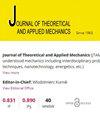基于ZMP公式和Flash-Hogan最小牵伸原理的动态稳定性生物力学判据
IF 1
4区 工程技术
Q4 MECHANICS
引用次数: 0
摘要
本文的主要目的是在Flash-Hogan原理和ZMP方法的基础上,定义一种动态稳定性判据。步态研究的重点是利用光学系统Optitrack对人体生物力学进行分析和观察。定义光滑参考轨迹,形成稳定模式。最优的,由于最小的震动标准,ZMP轨迹在结果部分中说明,以证明动态稳定模式的康复需要在神经肌肉损伤或损伤影响步态稳定性的情况下。本文章由计算机程序翻译,如有差异,请以英文原文为准。
Biomechanical criterion of dynamic stability based on ZMP formula and Flash-Hogan principle of minimum jerk
The main aim of the article is to define a criterion of dynamic stability based on the Flash-Hogan principle and the ZMP method. The gait researches were focused on analysis and observation of the human biomechanism with the optical system Optitrack. The smooth reference trajectory is defined forming a stability pattern. The optimal, due to the minimum jerk criterion, ZMP trajectory is illustrated in the results Section in order to demonstrate the dynamic stability pattern for the needs of rehabilitation in cases of neuromuscular damage or injuries affecting gait stability.
求助全文
通过发布文献求助,成功后即可免费获取论文全文。
去求助
来源期刊
CiteScore
1.40
自引率
14.30%
发文量
22
审稿时长
6 months
期刊介绍:
The scope of JTAM contains:
- solid mechanics
- fluid mechanics
- fluid structures interactions
- stability and vibrations systems
- robotic and control systems
- mechanics of materials
- dynamics of machines, vehicles and flying structures
- inteligent systems
- nanomechanics
- biomechanics
- computational mechanics

 求助内容:
求助内容: 应助结果提醒方式:
应助结果提醒方式:


